Fluffy Mighty White or the fuller texture of artisan sourdough? Taleggio, Teifi or prepacked slices? And what is the best way to cook your sandwich: grill, griddle, frying pan or toastie machine?
Before you dive below the line to scoff at the cheek of publishing a recipe for something as basic as a simple cheese toastie, consider this. Any idiot with a frying pan can make a grilled cheese sandwich - but how many are worthy of the enormous calorie load they pack? This is one recipe that deserves to be perfect; after all, if you eat too many of the things, life really will be too short to bother with a bad cheese sandwich.
For a start, as the good people of Twitter kindly inform me, the relationship between a cheese toastie and a grilled cheese sandwich is analogous, as I'd assumed, to that between macaroni cheese and mac and cheese - the latter being the bigger, brasher American version of our own, humbler family favourite. No, as Lynne Clark of the Greedy Piglet blog informed me, a grilled cheese sandwich is buttered on the outside and cooked in a pan, and the toastie is buttered on the inside and, well, toasted. As I don't own any variety of sandwich toaster for the sake of my health, this piece will concentrate on the fried variety (but let's keep calling it grilled, for the sake of our consciences).
The bread
The foundation of a good grilled cheese sandwich. Chef and food writer William Leigh advises me there's no point in using anything else but "shit white bread ... you'll struggle for a good seal, which is essential here". Later I read his email properly and discovered that he's talking toasties - a grilled cheese sandwich, he suggests, may require "something more robust". However, in the heat of the moment, the die is cast, and I've invested in some white sliced bread. Jamie Oliver also has strong feelings on the subject, writing in his new (and excellent) book Jamie's Comfort Food that "it's important to go for something neutral, and in my eyes, only a white bloomer will do."
The American magazine Cook's Illustrated suggest a "hearty white sandwich bread", which I equate to the bloomer. Gabrielle Hamilton of New York's Prune suggests something "rustic" and the website Serious Eats recommends a "hearty white bread" which "can't be too hole-y (or your cheese will drip out), and ... can't be sliced too thick (lest your cheese won't melt)". Daniel Doherty's Duck and Waffle cookbook uses sourdough, as do the grilled cheese sandwich street hawkers the Ghetto Grillz, while Nicholas Balfe of Brixton's Salon uses rye sourdough. (You see what I mean about this subject being more complex than meets the eye?)

Oliver and Leigh's softer breads have their charms, but more resistance is better here. Not because the sliced white is too delicate for the purpose - it stands up to its load of cheese remarkably well - but because sourdough offers a greater textural contrast with the gooey interior; a fluffy bread, especially of the "shit white" variety, is too yielding and gummy. Another important thing to note is that although, as Serious Eats say, too hole-y a bread puts the filling in jeopardy, a few more generous holes allow some to seep through and crisp up in patches: sourdough is the ideal candidate. And, although no doubt I'll be shot down for it by grilled cheese purists, I happen to like the stronger, more assertive flavour of the rye variety with the cheese. White, however, is perfectly acceptable.
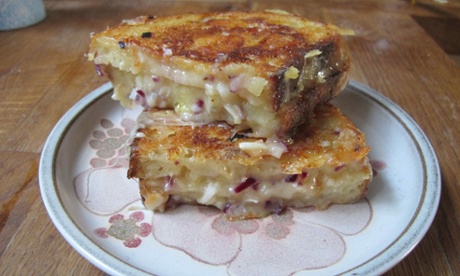
Ghetto Grillz (who source their bread from an artisan baker in Northumberland), have trodden this path before me, writing, "we have tried and tested many different thicknesses of bread and honestly feel 1cm is the perfect thickness. Just enough to absorb the gooey cheese inside and let the outside get nice and crispy as it grills." They're right; too thin and the cheese dominates, too thick and the bread burns before the filling melts.
The cheese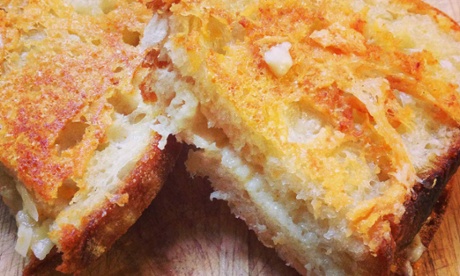
Here the cultural divide becomes apparent. With the exception of Leigh, who says he "swears by ... average supermarket red leicester for the cheese. Just tangy enough. Add cheap mozzarella for some extra stringiness," most British recipes go down Oliver's "good-quality" route. The man himself uses a mixture of red leicester and cheddar; Doherty goes for the soft Italian taleggio (which has excellent melting qualities) and Balfe Lincolnshire Poacher or good cheddar mixed with Teifi "or other Alpine-style cheese" and Stichelton "or other blue cheese". I can't find Teifi, a Welsh cheese, but finding it's modelled on a gouda, I substitute that instead.
The Ghetto Grillz, meanwhile, use two varieties of cheddar, Sussex Charmer and Singleton, explaining that "the reason we blend two cheeses is actually quite scientific. What we aim for is for one cheese to have a high fat content so it melts through the bread and effectively 'fries' it in lovely yummy cheese oil, but then we also want a gooey, piquant cheddary centre to be left inside once the toastie is cooked."
Across the pond, Hamilton uses an extra-sharp cheddar, Cooks Illustrated use cheddar and mild, creamy monterey jack, while Serious Eats suggest American cheese, jack or cheddar, cautioning that "a grilled cheese [sandwich] doesn't work with just any old cheese. You've got to have a cheese with just the right melting characteristics. Dry, crumbly, fresh cheeses like goat cheese won't melt properly. Ditto for overly aged cheeses like a parmesan or hard pecorino. For the true classic flavour, nothing is better than ultra-gooey, not-too-sharp American cheese." So, for the first time in my life, I purchase a packet of orange "cheese singles" individually wrapped in plastic and try not to cringe as they go through the check-out.
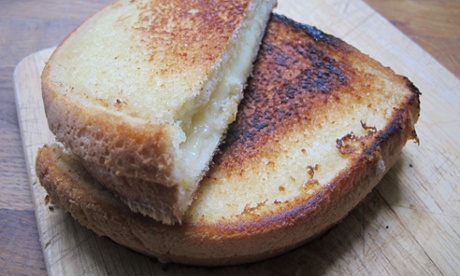
The results? Well, perhaps unsurprisingly, it all depends on personal taste, but whatever you go for, it pays to follow the same principle as everyone from Leigh to Cooks Illustrated and use a combination; one cheese for flavour, one for texture (if the second cheese also has a good flavour, that's a bonus). Leigh's supermarket red leicester and mozzarella makes for a ridiculously oozy, molten core, as does Lincolnshire Poacher cut with gouda, and Bermondsey-based Kappacasein's mix of montgomery cheddar with the softer, more pliable Ogleshield and comte.
Doherty's taleggio, though great on the melting front, is a little mild for my taste, while the less said about the American cheese experience the better. Though I discovered devoted fans in unexpected quarters, I found the gluey texture actively repellant. However convenient sliced cheese may be, grating the stuff gives a better result: if you don't believe me, listen to what sounds like the world's laziest cook: "as someone who hates cleaning the cheese grater, I resisted trying this tip for a long time. And then I tried it. And now I'm convinced. Grated cheese piled on the bread melts more evenly and more quickly than slices of cheese, thus guaranteeing that the bread is toasted and the cheese is melted in perfect synchrony." Amen to that - though I'll concede that Serious Eats are right when they say that many of the best melting cheeses are too soft to grate effectively. These, and these only, may be thinly sliced instead.
The extras
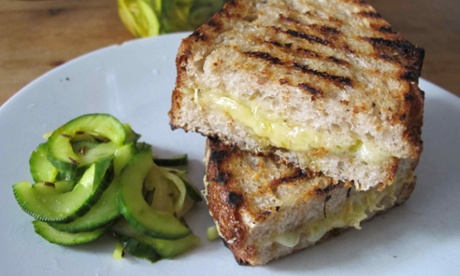
As with the variety of cheese, I wouldn't be too prescriptive here, because the world really is your oyster. Doherty puts braised ox cheek and pickled fennel and hollandaise sauce in the Duck and Waffle version (which may explain the mild cheese) with outrageously good results. I'm still haunted by the memory a good week on, so if you have any leftover slow-cooked meat in the fridge, bear his recipe in mind.
Indeed, pickles are a popular choice to cut through the richness of the cheese, with Balfe making some spicy pickled cucumbers and shallots as an accompaniment and Leigh suggesting adding pickled jalapenos or capers. All are definitely a good thing, in my opinion. Oliver is a big fan of a layer of leftover mashed potato, which he describes as "insanely good"; mash is never a bad thing, I'll grant you, but here it blends into the soft, fluffy bread, taking up room that, by rights, should be devoted to cheese. He also adds a sprinkling of cayenne pepper, which I'm a far bigger fan of.
The Ghetto Grillz, like Kappacasein, mix their cheese with finely diced onion and leek, with the latter adding garlic, too, and mature it overnight so the flavours have time to mingle. I feel like my growing aversion to all things raw onion-related slightly spoils this idea for me, but feel free to have a go if you're less narrow-minded - I'd be tempted by some slow-cooked leeks or red onions instead.
Other combinations I decide not to try for reasons of my sanity are Ghetto Grillz's sautéed mushrooms with truffle oil, Leigh's cavolo nero, roasted red peppers and spicy salami (or his cold sausages and ketchup), and any number of sobrasada and chorizo-related recommendations online. (If you do go down the extras route, the ever-helpful Leigh has another tip: "dice any fillings so they don't just come out in one hot strip of ham or salami".)
The fat
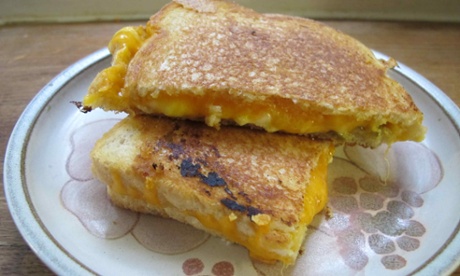
Butter is the most popular choice of fat for the grilled cheese sandwich, though even this isn't quite as simple as it may seem: Serious Eats and Doherty melt theirs in the pan, Cooks Illustrated brushes the bread with melted butter, Deb Perelman of the Smitten Kitchen blog butters her bread on the outside and Oliver butters both sides.
Hamilton, meanwhile, reckons mayonnaise is "the greatest cooking medium of all time for a grilled cheese sandwich" on the basis that it doesn't burn as quickly as butter, it doesn't stick to the pan, and "it browns and crisps more evenly, too". It also, she fails to mention, tastes like hot mayonnaise - tangy and, in my opinion, not half as nice as butter, which comes out as an early front runner.
Kappacasein, the Ghetto Grillz and Balfe all use oil instead, however, with the first two lightly greasing the pan or grill, and Balfe oiling the bread instead. I'm prepared to be sceptical here, but as long as you get the pan hot enough, and press down on the sandwiches with a weight, as Oliver and the Grillz recommend, you'll achieve a wonderfully crisp exterior, marbled with oil from the cheese, with the minimum of grease. (If it's grease you're after - if you're hungover, basically - then I'd recommend adding butter to the pan, or going with Leigh's cured pork fat, which is absurdly good if you can find the stuff.)
The method
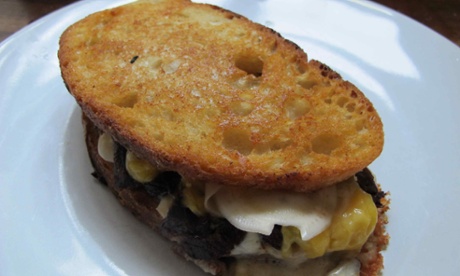
We've already covered the importance of pressing your sandwich for maximum surface contact - but what surface is best? I'm inclined to agree with Perelman and Hamilton and suggest a cast-iron frying pan here if possible - I've tried a griddle pan as well, which gives a pleasingly charred result, but doesn't provide the requisite contact for real crispness - on a medium heat only. As Oliver explains, "if it gets coloured too quickly you won't get the gorgeous ooze and melt in the middle".
If you're stuffing lots of other things in there, you might want to go down the Doherty route and finish it off in a hot oven to ensure everything has oozed together to your satisfaction.
Oliver and Perelman both go the extra mile and grate some cheese into the pan to create what the latter describes as a "frico" and the former "an impressive cheese crown". It's basically a cheese crisp on the outside of the sandwich and, while as delicious as a crisp made from cheese undoubtedly sounds, I feel you can have too much of a good thing. Feel free to ignore me. I have just eaten 10 grilled cheese sandwiches back to back, after all.
(Per sandwich)
A little oil, to grease
2 slices about 1cm thick of robust rye or white bread, preferably sourdough, with generous, but not excessive holes
35g cheddar, red leicester or any other hard cheese you like the flavour of
25g gouda, taleggio, comte, gruyere, mozzarella or any other melting cheese of your choice
Sprinkle of cayenne pepper
Pickles such as jalapenos, gherkins or onions, finely sliced if necessary (optional)
If you're making more sandwiches than you can fit in the pan at one time, heat the oven to 180C.
Grease a frying pan, ideally cast iron, with a little oil and set on a medium flame to heat up. Meanwhile, grate the cheeses, or finely slice the softer one if this is impossible (you may not need all of the cheese, depending on the size of your loaf). Toss together with the pickles, if using, along with a pinch of cayenne pepper.
Put the cheese on one of the slices of bread and top with the other. When the pan is hot, add it and weight it down with a small plate and something heavy (you could also press it down with a spatula if you don't mind standing over it while it cooks). Cook for 3-4 minutes until crisp and golden on the underside, then flip and repeat.
Serve immediately, or put in the oven while you repeat. Eat as soon as is comfortably possible.
Whether you're a grilled-cheese sandwich fan or the proud owner of a toasted sandwich gadget, what's the secret to perfection? We want cheeses, breads and ridiculous extras: as much as you can stuff in, whether that's Mighty White and value cheddar or Poilâne sourdough and époisses. Fire away.
Felicity Cloake's perfect grilled cheese sandwich. Photograph: Felicity Cloake for the Guardian






